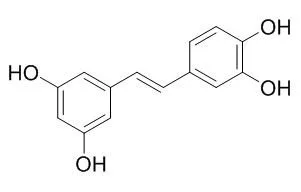| In vitro: |
| Int Immunopharmacol. 2015 Feb 9;25(2):285-292. | | Piceatannol inhibits effector T cell functions by suppressing TcR signaling.[Pubmed: 25676533] | Piceatannol, a metabolite of resveratrol found in red wine and grapes, displays a wide spectrum of biological activity. Although the anti-oxidant, anti-inflammatory, and anti-tumorigenesis activity of Piceatannol has been extensively studied, its role in the adaptive immune response has received less attention.
METHODS AND RESULTS:
Here we investigated the role of Piceatannol, a well-known Syk inhibitor, in T cell activation, proliferation, and differentiation using isolated murine splenic T cells from C57BL/6 mice. Piceatannol treatment inhibited surface expression of CD4 and CD8 T cell activation markers CD25 and CD69, reduced production of cytokines IFNγ, IL-2, and IL-17, and suppressed proliferation of activated T cells. Moreover, Piceatannol treatment significantly inhibited differentiation of CD4(+)CD25(-)CD62L(+) naïve CD4 T cells into Th1, Th2, and Th17 cells, presumably due to inhibition of TcR signaling through p-Erk, p-Akt, and p-p38.
CONCLUSIONS:
Piceatannol appears to be a useful nutritional or pharmacological biomolecule that regulates effector T cell functions such as cytokine production, differentiation, and proliferation. | | Phytother Res. 2014 Nov;28(11):1581-8. | | A review of the pharmacological effects of piceatannol on cardiovascular diseases.[Pubmed: 24919577] | The incidence of cardiovascular diseases (CVDs) is high in both developed and developing countries. It has a high global rate of mortality and causes heavy social burden. Drugs are available for managing or treating CVDs and its complications. Consumption of dietary supplements or functional foods for reducing the risk of CVDs has also gained wide recognition by the general public.
METHODS AND RESULTS:
Piceatannol, an analog and metabolite of resveratrol, is a natural stilbene commonly found in the skin of grapes and wine. Piceatannol is believed to be a potent compound with certain cardiovascular therapeutic effects, such as the prevention of hypercholesterolemia, arrhythmia, atherosclerosis, and angiogenesis. It also has vasorelaxation and antioxidant activities.
CONCLUSIONS:
A comprehensive review of Piceatannol concludes that Piceatannol has the potential to be developed into health products for the cardiovascular system to help modern society reduce the high CVD incidence. However, further investigations are warranted in order to increase the bioavailability and understand the biological mechanisms and safety of using Piceatannol. | | J Med Food . 2017 May;20(5):427-438. | | The Therapeutic Potential of Piceatannol, a Natural Stilbene, in Metabolic Diseases: A Review[Pubmed: 28387565] | | Abstract
Metabolic disease comprises a set of risk factors highly associated with obesity and insulin resistance and is a consequence of central adiposity, hyperglycemia, and dyslipidemia. Furthermore, obesity increases the risk of the development of metabolic disease due to ectopic fat deposition, low-grade inflammation, and systemic energy disorders caused by dysregulated adipose tissue function. Piceatannol is a naturally occurring polyphenolic stilbene found in various fruits and vegetables and has been reported to exhibit anticancer and anti-inflammatory properties. In addition, recently reported beneficial effects of Piceatannol on hypercholesterolemia, atherosclerosis, and angiogenesis underscore its therapeutic potential in cardiovascular disease. However, investigation of its role in metabolic disease is still in its infancy. This review intensively summarizes in vitro and in vivo studies supporting the potential therapeutic effects of Piceatannol in metabolic disease, including inhibition of adipogenesis and lipid metabolism in adipocytes, and regulation of hyperlipidemia, hyperglycemia, insulin resistance, and fatty acid-induced inflammation and oxidative stress.
Keywords: adipocytes; adipose tissue; bioavailability; insulin resistance; obesity; resveratrol. |
|
| In vivo: |
| Front Pharmacol . 2020 Jan 22;10:1613. | | Protective Effect of Piceatannol Against Acute Lung Injury Through Protecting the Integrity of Air-Blood Barrier and Modulating the TLR4/NF-κB Signaling Pathway Activation[Pubmed: 32038265] | | Abstract
Acute lung injury (ALI) is a common and complex inflammatory lung syndrome with higher morbidity and mortality rate. Piceatannol (PIC) has anti-inflammation and anti-oxidant properties. The study was designed to explore the effect and the action mechanisms of PIC on lipopolysaccharide (LPS)-induced ALI. Twenty-four hours after LPS challenge, mice from different treatment groups were euthanized, and the bronchoalveolar lavage fluid (BALF) and lung tissue samples were collected. Then the degree of pulmonary edema, lung pathological changes, myeloperoxidase (MPO) activity, and the production of pro-inflammatory cytokines were detected. Additionally, the messenger RNA (mRNA) expressions associated with cell adhesion molecules and tight junction were analyzed through quantitative real-time (qRT)-PCR, and the TLR4/NF-κB activation was examined by western blot. The results showed that PIC significantly inhibited LPS-induced lung edema, histopathological damage, MPO activity, cell infiltration, and pro-inflammatory cytokines production. Moreover, PIC notably suppressed mRNA expressions associated with inflammation and cell adhesion molecules. Furthermore, PIC also alleviated LPS-induced damage of air-blood barrier through reducing the levels of total proteins in BALF and recovering the expression of occludin and ZO-1 in the lung tissues. We also found that PIC remarkably restrained the LPS-induced TLR4/NF-κB pathway activation in lung tissues. In conclusion, PIC may be potential to treat LPS-induced acute lung injury (ALI) via regulating air-blood barrier and TLR4/NF-κB signaling pathway activation.
Keywords: TLR4/NF-κB; acute lung injury; air-blood barrier; lipopolysaccharide; Piceatannol. |
|






 Cell. 2018 Jan 11;172(1-2):249-261.e12. doi: 10.1016/j.cell.2017.12.019.IF=36.216(2019)
Cell. 2018 Jan 11;172(1-2):249-261.e12. doi: 10.1016/j.cell.2017.12.019.IF=36.216(2019) Cell Metab. 2020 Mar 3;31(3):534-548.e5. doi: 10.1016/j.cmet.2020.01.002.IF=22.415(2019)
Cell Metab. 2020 Mar 3;31(3):534-548.e5. doi: 10.1016/j.cmet.2020.01.002.IF=22.415(2019) Mol Cell. 2017 Nov 16;68(4):673-685.e6. doi: 10.1016/j.molcel.2017.10.022.IF=14.548(2019)
Mol Cell. 2017 Nov 16;68(4):673-685.e6. doi: 10.1016/j.molcel.2017.10.022.IF=14.548(2019)